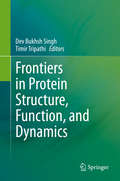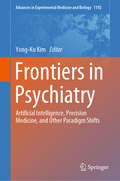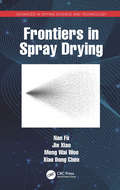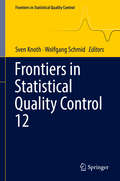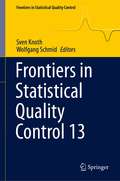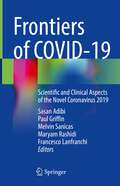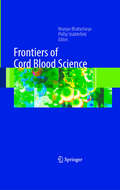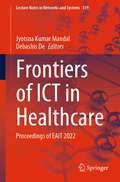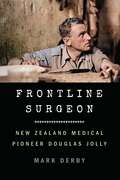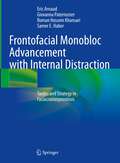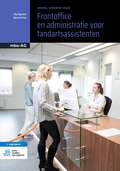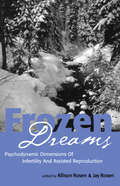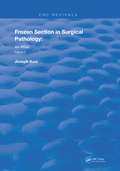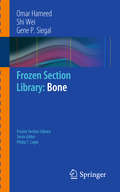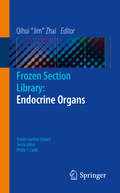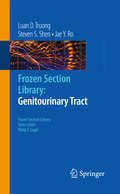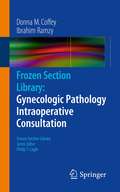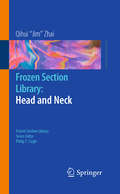- Table View
- List View
Frontiers in Protein Structure, Function, and Dynamics
by Dev Bukhsh Singh Timir TripathiThis book discusses a broad range of basic and advanced topics in the field of protein structure, function, folding, flexibility, and dynamics. Starting with a basic introduction to protein purification, estimation, storage, and its effect on the protein structure, function, and dynamics, it also discusses various experimental and computational structure determination approaches; the importance of molecular interactions and water in protein stability, folding and dynamics; kinetic and thermodynamic parameters associated with protein-ligand binding; single molecule techniques and their applications in studying protein folding and aggregation; protein quality control; the role of amino acid sequence in protein aggregation; muscarinic acetylcholine receptors, antimuscarinic drugs, and their clinical significances. Further, the book explains the current understanding on the therapeutic importance of the enzyme dopamine beta hydroxylase; structural dynamics and motions in molecular motors; role of cathepsins in controlling degradation of extracellular matrix during disease states; and the important structure-function relationship of iron-binding proteins, ferritins. Overall, the book is an important guide and a comprehensive resource for understanding protein structure, function, dynamics, and interaction.
Frontiers in Psychiatry: Artificial Intelligence, Precision Medicine, and Other Paradigm Shifts (Advances in Experimental Medicine and Biology #1192)
by Yong-Ku KimThis book reviews key recent advances and new frontiers within psychiatric research and clinical practice. These advances either represent or are enabling paradigm shifts in the discipline and are influencing how we observe, derive and test hypotheses, and intervene. Progress in information technology is allowing the collection of scattered, fragmented data and the discovery of hidden meanings from stored data, and the impacts on psychiatry are fully explored. Detailed attention is also paid to the applications of artificial intelligence, machine learning, and data science technology in psychiatry and to their role in the development of new hypotheses, which in turn promise to lead to new discoveries and treatments. Emerging research methods for precision medicine are discussed, as are a variety of novel theoretical frameworks for research, such as theoretical psychiatry, the developmental approach to the definition of psychopathology, and the theory of constructed emotion. The concluding section considers novel interventions and treatment avenues, including psychobiotics, the use of neuromodulation to augment cognitive control of emotion, and the role of the telomere-telomerase system in psychopharmacological interventions.
Frontiers in Spray Drying (Advances in Drying Science and Technology)
by Jie Xiao Meng Wai Woo Nan Fu Xiao Dong ChenThis book covers the latest developments and advances in spray drying and describes how they impact the basic aspect of designing and operating spray dryers. This generic approach allows users to understand how different basic aspects of spray drying have advanced. Users will learn how to apply these advances in their own specific spray drying applications. This book also discusses the handling and control of spray dried products. Includes the latest techniques for use in the design and operation of spray drying operations Covers the basic operations of spray drying that can be applied to different applications of spray drying Discusses the handling and control of spray dried product qualities from a general approach, allowing readers to tailor these approaches to their own specific products This book is aimed at professionals, researchers, and academics working in the fields of food, chemical, pharmaceutical, and industrial engineering.
Frontiers in Statistical Quality Control 12 (Frontiers in Statistical Quality Control)
by Sven Knoth Wolfgang SchmidThis book provides insights into important new developments in the area of statistical quality control and critically discusses methods used in on-line and off-line statistical quality control.The book is divided into three parts: Part I covers statistical process control, Part II deals with design of experiments, while Part III focuses on fields such as reliability theory and data quality. The 12th International Workshop on Intelligent Statistical Quality Control (Hamburg, Germany, August 16 – 19, 2016) was jointly organized by Professors Sven Knoth and Wolfgang Schmid. The contributions presented in this volume were carefully selected and reviewed by the conference’s scientific program committee. Taken together, they bridge the gap between theory and practice, making the book of interest to both practitioners and researchers in the field of quality control.
Frontiers in Statistical Quality Control 13 (Frontiers in Statistical Quality Control)
by Sven Knoth Wolfgang SchmidThis contributed book focuses on major aspects of statistical quality control, shares insights into important new developments in the field, and adapts established statistical quality control methods for use in e.g. big data, network analysis and medical applications. The content is divided into two parts, the first of which mainly addresses statistical process control, also known as statistical process monitoring. In turn, the second part explores selected topics in statistical quality control, including measurement uncertainty analysis and data quality.The peer-reviewed contributions gathered here were originally presented at the 13th International Workshop on Intelligent Statistical Quality Control, ISQC 2019, held in Hong Kong on August 12-14, 2019. Taken together, they bridge the gap between theory and practice, making the book of interest to both practitioners and researchers in the field of statistical quality control.
Frontiers of COVID-19: Scientific and Clinical Aspects of the Novel Coronavirus 2019
by Paul Griffin Sasan Adibi Melvin Sanicas Maryam Rashidi Francesco LanfranchiThis book aims to serve the critical interests of the global community by supplying the most current knowledge and understanding of Covid-19 epidemiology, treatment, and prognoses. There was much uncertain and contradictory information published in the first year of the novel coronavirus. The dynamics of COVID-19 have now been realized, including the type of antibodies produced in infected patients and their limited lasting endurance. This book will set the record straight on the concept of “herd immunity” and explore the current vaccine trials taking place in different countries. This comprehensive book will illuminate recent advances regarding COVID-19 and offer a possible roadmap on how to move forward. Frontiers of COVID-19: A Pathophysiology and Epidemiology Roadmap of Novel Coronavirus Disease will be a vital and forward-looking guide for infectious disease clinicians, scientists and researchers, and students at the graduate level.
Frontiers of Cord Blood Science
by Phillip Stubblefield Niranjan BhattacharyaCord blood is a significant source of hematopoietic stem and progenitor cells for the treatment of blood and genetic disorders. Cord blood is also an alternative to embryos as a source of tissue for regenerative medicine. Cells from cord blood have been shown to transdifferentiate into nonhematopoietic cells, including those of the brain, heart, liver, pancreas, bone, and cartilage, in tissue culture and in animal systems. Recently it has been demonstrated that both cardiac and glial cell differentiation of cord blood donor cells occurred in recipients of unrelated donor cord blood transplantation as part of a treatment regime for Krabbe disease and Sanfilippo syndrome. These observations raise the possibility that cord blood may serve as a source of cells to facilitate tissue repair and regeneration in the future. CD34 stem cell-rich umbilical cord whole blood transfusion has the potential to have an immediate benefit of better tissue oxygenation with an additional delayed benefit of possible engraftment of umbilical cord stem cells.
Frontiers of ICT in Healthcare: Proceedings of EAIT 2022 (Lecture Notes in Networks and Systems #519)
by Debashis De Jyotsna Kumar MandalThe book includes original unpublished contributions presented at the Seventh International Conference on Emerging Applications of Information Technology (EAIT 2022), organized by Computer Society of India, Kolkata, Chapter during March 30–31, 2022. The book covers the topics such as image processing for smart healthcare applications, computer vision and pattern recognition for health care, Internet of Health Things, 5G and beyond in smart health care for sustainable cities.
Frontiers of Statistics and Data Science (IISA Series on Statistics and Data Science)
by Subhashis Ghosal Anindya RoyThis book addresses a diverse set of topics of contemporary interest in statistics and data science such as biostatistics and machine learning. Each chapter provides an overview of the topic under discussion, so that any reader with an understanding of graduate-level statistics, but not necessarily with a prior background on the topic should be able to get a summary of developments in the field. These chapters serve as basic introductory references for new researchers in these fields, as well as the basis of teaching a course on the topic, or with a part of the course on topics of precision medicine, deep learning, high-dimensional central limit theorems, multivariate rank testing, R programming for statistics, Bayesian nonparametrics, large deviation asymptotics, spatio-temporal modeling of Covid-19, statistical network models, hidden Markov models, statistical record linkage analysis. The edited volume will be most useful for graduate students looking for an overview of any of the covered topics for their research and for instructors for developing certain courses by including any of the topics as part of the course. Students enrolled in a course covering any of the included topics can also benefit from these chapters.
Frontline Surgeon: New Zealand Medical Pioneer Douglas Jolly
by Mark DerbyAlthough a young doctor when he volunteered for the Spanish Civil War in late 1936, New Zealander Douglas Jolly swiftly acquired a reputation as one of the most gifted and energetic surgeons of the Republican Army&’s medical services. Over the next two years he performed countless life-saving operations on wounded combatants from both sides of the conflict, as well as on civilians. Tireless, dedicated, and courageous, he developed significant and innovative treatment systems based on the principle of working as near as possible to the front line. Jolly used this unprecedented battlefield experience to write a manual that was widely used in World War II and the Korean and Vietnam Wars.Frontline Surgeon traces Jolly&’s remarkable career from medical training in 1920s New Zealand, postgraduate study during the rise of fascism in Europe, almost a decade of frontline surgery, and into civilian life as medical director of Britain&’s largest hospital for amputees. One of the greatest war surgeons of the twentieth century, Jolly has been mysteriously omitted from the ranks of pioneers of modern medicine. This engaging biography, intensively researched in many countries, both explains and redresses that omission.
Frontofacial Monobloc Advancement with Internal Distraction: Tactics And Strategy In Faciocraniosynostosis
by Eric Arnaud Giovanna Paternoster Roman Hossein Khonsari Samer E. Haber<p>Based on the experience at one of the largest centers for craniosynostosis and craniofacial malformations, this book reports on the clinical use of a rare technique known as Frontofacial Monobloc Advancement (FFMBA), one of the most rewarding procedures for upper- and mid-face reconstruction in patients with faciocraniosynostosis, a rare craniofacial anomaly associated with premature fusion of multiple cranial sutures presenting with brachycephaly, orbital proptosis, maxillary hypoplasia and anterior crossbite. Technical refinements and strategic planning have made it almost a routine procedure at the French Reference Center for Craniosynostosis and Craniofacial Malformations.<p> <p>This easy-to-consult, well illustrated book includes technical tips and indications for its use in Crouzon, Pfeiffer and Apert syndromes. It also provides a prool, including a proposed management algorithm for faciocraniosynostosis. As such, it will appeal to craniofacial surgeons, especially those at large craniofacial centers.<p>
Frontofacial Monobloc Advancement with Internal Distraction: Tactics and Strategy in Faciocraniosynostosis
by Eric Arnaud Giovanna Paternoster Roman Hossein Khonsari Samer E. HaberBased on the experience at one of the largest centers for craniosynostosis and craniofacial malformations, this book reports on the clinical use of a rare technique known as Frontofacial Monobloc Advancement (FFMBA), one of the most rewarding procedures for upper- and mid-face reconstruction in patients with faciocraniosynostosis, a rare craniofacial anomaly associated with premature fusion of multiple cranial sutures presenting with brachycephaly, orbital proptosis, maxillary hypoplasia and anterior crossbite.Technical refinements and strategic planning have made it almost a routine procedure at the French Reference Center for Craniosynostosis and Craniofacial Malformations. This easy-to-consult, well illustrated book includes technical tips and indications for its use in Crouzon, Pfeiffer and Apert syndromes. It also provides a protocol, including a proposed management algorithm for faciocraniosynostosis. As such, it will appeal to craniofacial surgeons, especially those at large craniofacial centers.
Frontoffice en administratie voor tandartsassistenten (Basiswerk AG)
by Maria de Vries Elly HogeveenDit studieboek is bedoeld voor studenten van de mbo-opleiding tandartsassistent. De theorie en verwerkingsopdrachten helpen je bij de communicatie met patiënten en een goede tandheelkundige administratie te voeren, zowel in de frontoffice, backoffice als aan de behandelstoel. Het leert je hoe je een patiëntenadministratie voert en hoe je declaraties correct afhandelt. Daarbij is inzicht en kennis van wet- en regelgeving noodzakelijk. Het studieboek is bedoeld voor assistenten in opleiding, maar is ook geschikt als naslagwerk voor medewerkers in de mondzorgpraktijk.Deze vierde druk is geactualiseerd na de invoering van het nieuwe kwalificatiedossier. Het boek is uitgebreid met nog meer kennis en vaardigheden. De theorie is waar mogelijk zo veel mogelijk versimpeld en er zijn nieuwe afbeeldingen toegevoegd. Er staan veel verwerkingsopdrachten in om zelf te kunnen oefenen met de lesstof. Ten slotte is het laatste hoofdstuk over beheertaken uit dit boek verwijderd. Het boek Management, beheer en organisatie voor tandartsassistenten voorziet in de behoefte aan meer uitleg en informatie over dit thema en veel meer. Elly Hogeveen is van oorsprong tandarts- en preventieassistent en is docent aan de opleiding tot tandartsassistent aan ROC Friese Poort in Leeuwarden. Ook is zij praktijkmanager in een tandartsenpraktijk te Grou. Maria de Vries is begonnen als tandartsassistent en is docent aan de opleiding tot tandartsassistent aan de Noorderpoort in Groningen. Tevens is zij praktijkmanager in een tandartsenpraktijk te Burgum. Beiden verzorgen een breed scala aan lessen over administratie, management, beheer & organisatie, praktijkvoering en omgangskunde.
Frontoffice en administratie voor tandartsassistenten (Basiswerk AG)
by Maria de Vries Elly HogeveenDit studieboek helpt je een goede tandheelkundige administratie te voeren zowel in de frontoffice als aan de behandelstoel. Het leert je de patiëntenadministratie en de bijbehorende declaraties correct af te handelen, rekening houdende met de wet- en regelgeving. Het boek Frontoffice en administratie voor tandartsassistenten is bedoeld voor tandartsassistenten in opleiding, maar is ook een prima naslagwerk voor medewerkers in de mondzorgpraktijk. Deze vijfde druk is geactualiseerd. De theorie is daar waar mogelijk versimpeld en aangevuld met nog betere afbeeldingen. Er staan nog steeds veel opdrachten in om zelf te kunnen oefenen met de lesstof. Elk hoofdstuk kan worden afgesloten met een theorietoets. Elly Hogeveen is van oorsprong tandarts- en preventieassistent, heeft jarenlange ervaring als docent aan de opleiding tot tandartsassistent in Leeuwarden. Daarnaast heeft ze gewerkt als praktijkmanager in een tandartsenpraktijk te Grou. Op dit moment is zij werkzaam als teamleider bij Firda, mbo-college Sneek. Tevens schrijft zij de opdrachten voor het Nederlands Kampioenschap tandartsassistent van WorldSkills Netherlands, en is ze verantwoordelijk voor de organisatie van The Finals van WorldSkills. Maria de Vries is ook begonnen als tandartsassistent en is op dit moment docent aan de opleiding tot tandartsassistent in Groningen. Tevens is zij praktijkmanager bij Tandartsenpraktijk Burgum. Daarnaast is zij vaststeller van de Proeves van Bekwaamheid en keuzedelen van Dentallect en is lid van de adviesraad van E-Wise.
Frontotemporal Dementias: Emerging Milestones of the 21st Century (Advances in Experimental Medicine and Biology #1281)
by Bernardino Ghetti Emanuele Buratti Bradley Boeve Rosa RademakersUnder the name of Frontotemporal Dementias (FTD) numerous hereditary and sporadic disorders are listed. FTD may take away speech and language, social skills and ethical judgement, wishes and will, empathy and emotions; it may also impair motor functions. FTD may affect men and women in midlife or during old age leading to the demolition of the uniqueness of the human mind. In the last decade of the 20th century and in the first two decades of the 21st century, progress in the understanding of clinical, neuropathological, biochemical, and genetic aspects of FTD has accelerated. The novel awareness about FTD has directed young generations of researchers toward the study of this complex group of disorders. This Volume has been formulated with the participation of some of the leading scientists who have contributed to the development of knowledge in the clinical and basic science arenas. It captures the current central elements that are relevant to an up-to-date understanding of causes and pathogenesis of multiple forms of FTD. The volume is an opus that represents a distillation of the work of many scientists and addresses the current directions in the study of one of the most complex groups of diseases. In view of its structure, the book could also be used as a textbook, that offers both a broad and deep analysis of major areas in FTD. This book, planned by the International Society for Frontotemporal Dementias, is distinctive as it opens a window to a wide landscape about the biology of FTD. Thus, the book represents a moment of reflection on the present state of our knowledge of FTD and a collective vision toward scientific progress. The authors of each chapter share their knowledge and vision aimed at reducing the suffering which is caused by FTD.
Frozen Dreams: Psychodynamic Dimensions of Infertility and Assisted Reproduction
by Jay Rosen Allison RosenWedding up-to-date scientific information to an understanding of the emotional burdens and ethical dilemmas that inhere in reproductive medicine, Frozen Dreams: Psychodynamic Dimensions of Infertility and Assisted Reproduction provides an overview of the psychology of infertility patients and of the evaluative, administrative, and especially psychotherapeutic issues involved in helping them. The contributors to this volume, who include professionals from nationally prestigious reproductive programs as well as psychotherapists who evaluate and work clinically with infertility patients, explore the complex choices about life and death that are the daily experience of infertility specialists. In voices equally authoritative and intimate, psychotherapists and other health professionals explore the therapeutic process with patients and couples struggling with miscarriage, infertility, childlessness, the possibility of adoption, and the promise of assisted pregnancy. And the contributors are equally attentive to the range of issues that challenge physicians and nurses active in reproductive medicine, intent on providing practical information that will aid decision-making in this demanding area of practice. Written for a large audience of psychiatrists, psychologists, social workers, researchers, nurses, physicians, and general readers, Frozen Dreams is a fascinating introduction to the human face of reproductive medicine. Filled with intriguing and edifying case histories, it will appeal to all mental health professionals who work with adult patients through their childbearing years. For professionals who work inside the complex world of infertility treatment, Frozen Dreams will quickly become an essential text that is turned to repeatedly for information, guidance, reassurance, and revitalization.
Frozen Section In Surgical Pathology: An Atlas Volume 2 (Routledge Revivals)
by Joseph KoviPublished in 1983: In this Atlas the discussion of equipment, technique, its nuances, and problems is followed by clinical and pathological presentations.
Frozen Section Library: Appendix, Colon, and Anus
by Philip T. Cagle Rhonda K. Yantiss Nicole C. PanarelliAs a handbook for practicing pathologists, this book will be an indispensable aid to diagnosis and avoiding dangers in one of the most challenging situations that pathologists encounter. Rapid consideration of differential diagnoses and how to avoid traps caused by frozen section artifacts will be readily accessible to the users of this handbook. Currently, there is no other up-to-date single-source reference specifically focused on frozen sections of the lower gastrointestinal tract.
Frozen Section Library: Bone
by Philip T. Cagle Omar Hameed Gene P. Siegal Shi WeiFrozen sections are performed while a patient is undergoing surgery as a basis for making an immediate diagnosis that will impact treatment decisions. Frozen section diagnosis is often a highly demanding situation for the pathologist who must render a diagnosis quickly for the patient and surgeon. The Frozen Section Library series will provide concise, user-friendly, site specific handbooks that are well illustrated and highlight the pitfalls, artifacts and differential diagnosis issues that arise in the hurried frozen section scenario.
Frozen Section Library: Breast
by Syed K. MohsinThe Frozen Section Library series provides concise, user-friendly, site specific handbooks that are well illustrated and highlight the pitfalls, artifacts and differential diagnosis issues that arise in the hurried frozen section scenario. Frozen Section Library: Breast provides an easy reference and pocket book about the nuances of adequately handling breast specimens in a fashion that meets the increasingly complex environment of breast pathology. The pros and cons of frozen section versus use of touch imprint as well as related quality assurance requirements are addressed. Other less common uses of intraoperative evaluation, such as diagnosis and margin evaluation are described. The volume includes recommended guidelines for evaluation and documentation of specific gross pathologic features, in conjunction with radiological imaging. Techniques and protocols for such examinations are illustrated. The volume closes with an overview of the newly published guidelines for handling a variety of breast specimens, which are intended to be used for assessment of predictive factors. Syed K. Mohsin, M.D. is the Head of Breast Pathology and Medical Director, Immunohistochemistry, Riverside Methodist Hospital, Columbus, OH
Frozen Section Library: Central Nervous System
by Philip T. Cagle Richard A. Prayson Karl M. NapekoskiFrozen section of Neuropathology-related cases is performed while the patient is undergoing surgery. Intraoperative consultation is used to help guide intraoperative management of the case and to ensure that adequate and appropriate tissue has been obtained for purposes of making an accurate final diagnosis. Frozen section diagnosis is often a highly demanding situation for the pathologist, who must render a diagnosis quickly and provide sound guidance and advice. In addition to the need for rapid recall of differential diagnoses, there are many pitfalls and artifacts that add to the risk of frozen section diagnosis that are not present with permanent sections of fully processed tissue that can be examined in a more leisurely fashion. Most standard pathology textbooks focus primarily on permanent section material and largely ignore the topic of frozen section. The purpose of this volume is to add to the Frozen Section Library series and provide a convenient, user friendly handbook to assist in the evaluation of central nervous system related frozen sections. It provides a useful reference, organized around differential diagnoses, primarily by location in the central nervous system. The text will be illustrated with color pictures and include tables as appropriate. This text provides a valuable tool for the practicing surgical pathologist both in community and in academic centers as well as pathology residents and fellows in training when confronted with Neuropathology frozen section.
Frozen Section Library: Endocrine Organs
by Qihui Jim" ZhaiThe Frozen Section Library series provides concise, user-friendly, site specific handbooks that are well illustrated and highlight the pitfalls, artifacts and differential diagnosis issues that arise in the hurried frozen section scenario. Written by expert surgical pathologists, Frozen Section Library: Endocrine Organs presents common and practical problems including follicular adenoma versus follicular carcinoma, papillary thyroid carcinoma versus reactive change and freezing artifact, follicular variant of papillary thyroid carcinoma, and medullary thyroid carcinoma. Anaplastic carcinoma, thyroid lymphoma, resection margin of a pancreatic endocrine tumor, pheochromocytoma within an adrenal gland and extra- adrenal gland, parathyroid tissue versus a thyroid tissue and versus a lymph node are also explored in detail. All chapters are illustrated with color pictures and accompanied legends. As a handbook for practicing pathologists, this volume is an indispensable aid to diagnosis and for avoiding dangers in one of the most challenging situations that pathologists encounter. Rapid consideration of differential diagnoses and how to avoid traps caused by frozen section artifacts are readily accessible. Tables and charts provide guidance for differential diagnosis of various histological patterns. Frozen Section Library: Endocrine Organs is a highly valuable guide for practicing surgical pathologists, both community and academic, and to pathology residents and fellows. Qihui "Jim" Zhai, MD, FCAP, is Professor of Laboratory Medicine and Pathology, Mayo Clinic Florida, Jacksonville, FL.
Frozen Section Library: Genitourinary Tract
by Philip T. Cagle Jae Y. Ro Luan D. Truong Steven S. ShenFrozen sections are performed for the purpose of rapid diagnosis while a patient is undergoing surgery, usually under general anesthesia, as a basis for making immediate treatment decisions. Therefore, frozen section diagnosis is often a highly demanding situation for the pathologist who must render a diagnosis quickly and a crucial determination for the patient and surgeon. In addition to the need for rapid recall of differential diagnoses, there are many pitfalls and artifacts that add to the risk of frozen section diagnosis that are not present with permanent sections of fully processed tissues that can be examined in a more leisurely fashion. Most standard pathology textbooks, both general and subspecialty, largely ignore the topic of frozen section. Few textbooks have ever focused exclusively on frozen section diagnosis and those textbooks that have done so are now out-of-date and have limited numbers of black and white figures. None has emphasized the education of the surgeon in terms of frozen section benefits, limitations or proper utilization. The Frozen Section Library series will provide convenient, user-friendly handbooks for each organ system to expedite use in the hurried frozen section situation. These books will be small and light-weight, copiously color illustrated with images of actual frozen sections, highlighting pitfalls, artifacts and differential diagnosis. These books will also include perspectives for the surgeon and for communication with the surgeon and suggest ancillary procedures (for example, when to take tissue for microbiology cultures). Each 5 X 8 book is estimated to be about 200 to 250 pages in toto with 100 to 150 color figures each. As a handbook for practicing pathologists, these books will be indispensable aids to diagnosis and avoiding dangers in one of the most challenging situations that pathologists encounter. Problems, such as differentiation of benign processes from malignant neoplasms which may be more difficult on frozen section than permanent section and which have a serious impact on the surgeon's immediate treatment decisions, will be emphasized. Rapid consideration of differential diagnoses and how to avoid traps caused by frozen section artifacts will be readily accessible to the users of the handbooks. A series of concise, easy-to-use, well-illustrated handbooks alleviates the often frustrating and time-consuming, sometimes futile, process of searching through bulky textbooks that are unlikely to illustrate or discuss pathologic diagnoses from the perspective of frozen sections in the first place. Tables and charts will provide guidance for differential diagnosis of various histologic patterns. The advantages of a series of organ-specific handbooks, in addition to the ease-of-use and manageable size, is that (1) it allows more comprehensive coverage of more diagnoses, both common and rare, than a single volume that tries to highlight a limited number of diagnoses for each organ and (2) it allows more detailed insight by permitting experienced authorities to emphasize the peculiarities of frozen section for each organ system. Although some differences in practice of frozen section exist between different institutions, such as differing policies regarding whether or not to perform frozen section on specific types of specimens, these differences are generally not significant and can be discussed ( an organ-specific handbook by an expert in that organ system permits more opportunity for this type of discussion). Touch preparations, which are used for some organs such as central nervous system or thyroid more often than others, will be appropriately emphasized and illustrated according to the need for each specific organ. This series will be highly valuable to practicing surgical pathologists, both community and academic, and to pathology residents and fellows. The perspectives provided will also be valuable to surgeons and especially to surgery residents and fellows who must answer questions about pathology and frozen section on their board examinations....
Frozen Section Library: Gynecologic Pathology Intraoperative Consultation
by Ibrahim Ramzy Donna M. CoffeyFrozen sections are performed while a patient is undergoing surgery as a basis for making an immediate diagnosis that will impact treatment decisions. Frozen section diagnosis is often a highly demanding situation for the pathologist who must render a diagnosis quickly, based on careful gross examination of specimens to select optimal areas for microscopic examination. The Frozen Section Library series will provide concise, user-friendly, site specific handbooks that are well illustrated and highlight the pitfalls, artifacts and differential diagnosis issues that arise in the hurried frozen section scenario. Donna M. Coffey, M.D., is Assistant Professor, Department of Pathology and Laboratory Medicine, The Methodist Hospital, Houston, Texas and Weill Medical College of Cornell University, New York, New York. Ibrahim Ramzy, M.D., is Professor of Pathology - Laboratory Medicine & Obstetrics-Gynecology, University of California, Irvine, California and Adjunct Professor of Pathology, Baylor College of Medicine, Houston, Texas.
Frozen Section Library: Head and Neck
by Philip T. Cagle Qihui Jim ZhaiIntraoperative frozen section interpretation is the base for treatment for the patient within the operating room. It requires immediate answer for the surgeon's specific question and the subsequent consequences are frequently irreversible. The pathologist should be very familiar with the related differential diagnosis of the involved organ. Additionally, the pathologist needs to know many pitfalls and freezing artifacts in each organ and the clinical implications each diagnosis may result in. Frozen Section Library: Head and Neck will provide a convenient, user-friendly handbook to expedite use when performing intraoperative consultations on head and neck specimens. This book will be 5 X 8 and is estimated to be about 200 to 250 pages in toto with 100 to 150 color figures. An organ and clinical scenario based approach will be used in this book. This book will be divided into chapters based on the organs and anatomic locations. Within the chapter, a consistent format with the critical issues as a focus will be used including the frequently encountered clinical scenarios and the specific questions from the surgeons, frequent diagnostic considerations and their major diagnostic criteria with associated diagnostic pearls, artifacts and pitfalls and how to avoid them. Common and practical problems including reactive atypia versus carcinoma in salivary glands, resection margins in tongue and laryngectomy specimens, small blue cell tumors in the base of the skull, a primary lesion versus a metastatic squamous carcinoma in the neck, etc. will be illustrated with color pictures and accompanied legend. As a handbook for practicing pathologists, this book will be an indispensable aid to diagnosis and avoiding dangers in one of the most challenging situations that pathologists encounter. Rapid consideration of differential diagnoses and how to avoid traps caused by frozen section artifacts will be readily accessible to the users of this handbook. Tables and charts will provide guidance for differential diagnosis of various histological patterns. This book will be highly valuable to practicing surgical pathologists, both community and academic, and to pathology residents and fellows. The perspectives provided will also be valuable to head and neck surgeons and especially to surgery residents and head and neck surgery fellows who must answer questions about pathology and frozen section on their board examinations. This handbook will be easily portable by the individual but it is envisioned that many departments will want to also keep copies readily available in the frozen section laboratory.
